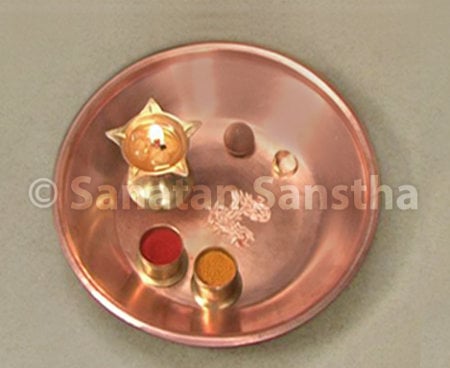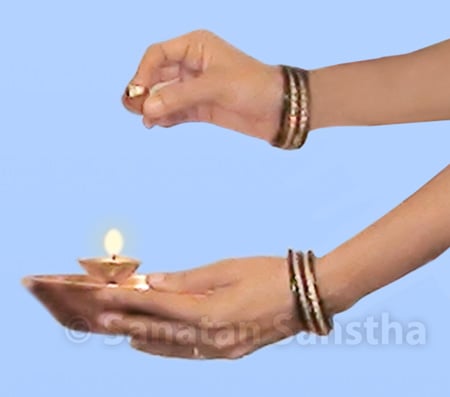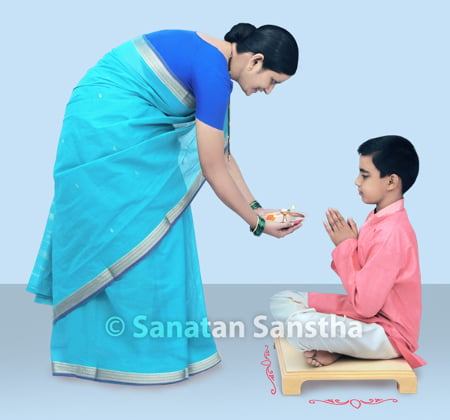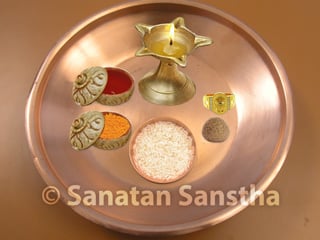
A ritual of waving a lit lamp
in front of a Saint or an individual
There are various pre-requisites for conducting any ritual. Performing aukshan (ritual of waving a lit lamp in front of Saints or individual) is no exception. In order to derive maximum spiritual benefits, we need to conduct aukshan as per the scriptures. In this article, we provide detailed steps for experiencing bliss by performing aukshan accordingly.
1. Objects required for aukshan and
their arrangement in the ritualistic platter
A. Articles required for aukshan
Haldi-kumkum (Turmeric powder and saffron), akshata (Unbroken rice grains), cotton wicks, oil, niranjan (A five-petalled metal lamp-dish with an attached conical stand to be set before an Idol), gold ring, whole betel-nut etc.

B. Arrangement of articles in the ritualistic platter and spiritual science underlying it
1. On left side of the ritualistic platter, haldI and kumkum are placed as a symbol of Adishakti (Primal Energy) that provides energy required for any action. Pavitraks (Subtlemost particles of Chaitanya (Divine consciousness) of the Deities) from the Universe are attracted towards the subtle fragrance emitted by haldi and kumkum.
2. A gold ring and betel-nut are placed on the right side to symbolise the active Shiv (God) Principle.
3. Since the akshata are all-encompassing in nature, they are kept in the centre of the ritualistic platter.
4. The lit lamp is placed in the centre just in front of the akshata. The lit lamp symbolizes the Sushumna-nadi, which is activated by the energy of the individual. When the Adishakti received through haldi-kumkum unites with the Shiv Principle received through the gold ring and betel-nut, the blessings flowing from the Deity through the medium of the akshata move towards the individual. Due to activation of Sushumna-nadi in the indvidual through the medium of the lamp, the task undertaken by the individual attains success by the grace of God.
Thus, the correct arrangement of the articles in the ritualistic platter helps the individual in obtaining greater benefit of the Divine Principle. – A Scholar (Through the medium of Mrs Anjali Gadgil)
Why is arrangement of haldi-kumkum in
ritualistic platter for aukshan and puja opposite ?
Question : It has been said that, when arranging the ritualistic platter for aukshan, haldi and kumkum are to be placed on the left side, while in the ritualistic platter arranged for puja (Ritualistic worship), haldi and kumkum are to be placed on the right side. How does one understand this contradiction?
Answer : Arrangement of the articles in the ritualistic platter for puja is done with an all-pervasive bhav (Spiritual emotion), with the only objective that the respective Divine Principle gets attracted and the place of worship gets purified. All the ingredients included are associated with colour and fragrance. Amongst these items, Shakti enhancing, active, Raja-predominant, Sagun (Materialised)-tattva (Principle) is attracted to haldI and kumkum in greater proportion and hence they are placed on the right side of the individual. In comparison, the ritualistic platter used for aukshan is at a relatively inferior level. A gold ring and a betel-nut find a place in this ritualistic platter additionally. As a result, instead of haldi and kumkum the respective Principle gets attracted to the Raja component which is operational at a lower level, . Hence, haldi and kumkum are shifted to the left side. At the same time, the ring and the betel-nut, which are Raja-predominant components, are more active; hence, they are given place on the right side in the ritualistic platter. In short, depending on the active Raja-predominant intent in the respective ritual, the related components are placed on the right or left side of the individual. (Through the medium of Mrs Anjali Gadgil, 21.11.2006)
2. Method of aukshan

2 A. Place a wooden seat and draw a design with rangoli (Holy designs made on the ground from white crushed powder) around it. Let the individual (on whom the ritual is to be performed) sit on a wooden seat.
2 B. Apply wet kumkum to the forehead of the individual using the tip of the middle finger, starting from the mid-brow region and sliding upwards. Apply akshata on it.
2 C. With the ritualistic platter containing the lit niranjan in the left hand, lift the gold ring (or any other ornament) and the betel-nut together with the right hand and move them around the face in the following manner.
2 C 1. Commence by touching the gold ring and the betel-nut to the Adnya-chakra of the individual.
2 C 2. Then move the gold ring and the betel-nut from the right shoulder of the individual, in a clockwise direction to the left shoulder and then in the reverse direction, that is, from the left to the right shoulder. Repeat this thrice. Each time, touch the ring and the betel-nut to the ritualistic platter.
2 D. Move the ritualistic platter around the individual on whom the ritual is being performed. Any one of the following methods can be used.
1. To the individual seated on a wooden seat, the ritualistic platter with the lit lamp should be waved from the right knee to the left knee in a clockwise direction and then back to the right knee, anticlockwise. This should be done thrice.
2. To the individual sitting in a chair, the ritualistic platter with the lit lamp should be waved from the right foot upwards in a clockwise direction upto the left foot, and back the same way to the right foot. This should be done thrice.
3. Start moving the ritualistic platter with the lit lamp from the right shoulder in a clockwise direction to the left shoulder, and then back the same way. This should be done thrice.
Spiritual Science : By waving the lamp in a semicircular manner, negative energy in the jīva have an outlet to leave the body. If waved in a circular manner, a protective ring is formed around the body, increasing the possibility of negative energy remaining trapped in the body of the individual.
2 E. Give the individual a sweet item to eat.
2 F . Pray for the well-being of the individual whose aukshan is being performed.
2 G . Before placing the ritualistic platter on the floor, place some akshata beneath it.
3. Spiritual science underlying
the actions performed during aukshan
3 A. Why apply akshata over the kumkum applied to the forehead of the individual on whom the ritual is being performed?

When the ritualistic platter is moved, the swiftly revolving Raja-predominant waves emitted from the lamp are retained by the akshata due to their predominance in Apa-tattva (Absolute Water Principle) and Pruthvi-tattva (Absolute Earth Principle). These waves are then emitted by the Adnya-chakra into the body of the individual as required. At this point, since the Kriya-shakti (Energy of action) of the Raja-predominant waves is reduced, they are converted into sattvik-waves. Since the speed of sattvik-waves is much less when compared with their earlier form, they spread slowly into the body. Thus, the benefit of the sattvikta that the individual gets lasts for a longer period and it does not suffer from any distress either. – A Scholar (Through the medium of Mrs Anjali Gadgil, 20.11.2004)
Note 1: The spiritual level of an average individual is not high enough and hence if a large number of sattvik-waves are imbibed at the same time, the body does not have the ability to sustain them. Therefore, there is a possibility of experiencing physical distress such as heaviness and numbness of head, lethargy etc.
3 B. While performing aukshan why is a gold ring and betel-nut held in the hand and waved around the individual?
Waving the betel-nut together with the gold ring complements the sattvikta in the gold ring with the Raja component in the betel-nut, thus imparting momentum and making it sustainable and beneficial for the individual
A gold ring and betel-nut are complementary to the task being performed by the individual. A prayer made before performing aukshan unto the Deity with a bhav (Spiritual emotion) of surrender charges all the ingredients on the ritualistic platter with sattvik-waves emitted from the Deities. Since the gold ring is predominant in Sattva component, Sattva-waves emitted from the ring partly acquire the Raja component due to the Apa-tattva emitted by the betel-nut, and thus gain momentum. This helps in converting the waves emitted from the gold ring into Sagun (Materialised) waves that the individual is able to sustain; and the individual imbibes the Principle of the Deity as per its ability – A Scholar (Through the medium of Mrs Anjali Gadgil, 28.1.2005)
3 C. Why is the gold ring touched to the ritualistic platter after waving it around the face ?
When the gold ring is touched to the ritualistic platter after waving it around the individual, both the individual and the one performing the ritual are benefited from the sattvik-waves
During aukshan, due to the bhav of the individual the sattvik-waves present in the Universe are activated and are attracted towards the gold ring held in the hand. When the gold ring is waved around the individual, these waves are converted into Raja-predominant waves and a protective sheath of the waves is formed around the individual. When the gold ring which is charged with sattvik-waves, is touched to the ritualistic platter, the waves in it are attracted towards the ritualistic platter. As a result, both the individuals (the one on whom the ritual is being performed and the one performing the ritual) get the benefit of the sattvik-waves. – A Scholar (Through the medium of Mrs Anjali Gadgil, 7.8.2004)
Question : Even if the gold ring is not touched to the ritualistic platter, the individual on whom the ritual is being performed would still benefit directly from the sattvik-waves emitted by the ring. Then what is the need for this additional exercise?
Answer : When the ritualistic platter is waved in a circular manner around the individual after having touched the gold ring to it, the sattvik-waves emitting from the ritualistic platter get converted back to Raja-predominant waves. The individual on whom the ritual is being performed again benefits from this and a protective sheath is formed around it.
Question : Ultimately, even if the niranjan is waved by wearing the gold ring on the finger, the individual will still avail of all the above mentioned benefits. Then why is this not done?
Answer : The proportion of trigun (The three basic components of the human body – Sattva, Raja and Tama) in a charged metal lasts for a longer period than it lasts in our body. Wearing the gold ring on the finger can alter the proportion of trigun in it. Hence, as far as possible, avoid waving the niranjan while wearing the gold ring. (Through the medium of Mrs Anjali Gadgil, 8.8.2004)
3 D. What is the spiritual science underlying the use of an ornament instead of a coin in aukshan ?
Metal ornaments are used instead of coins in the ritual to facilitate imbibing of the relevant waves from a specific metal by average individuals
When a coin or a flat strip of gold or silver is used for the ritual, because of their large flat top-side the level of the waves emitted is associated with the Sattva-component of the Nirgun (Non-materialised) form. On the other hand, if ornaments of these elements are used then because of the design they have their ability to emit Sagun related waves having Raja-predominance increases. These waves are of an inferior level when compared with the Sattva-predominant waves, due to which they can easily be imbibed by an average individual. Thus an individual can be benefited from the respective waves at respective level. Hence, preferably ornaments should be used in the aukshan.
3 E. Why is the ritualistic platter with the lit lamp moved only once while performing aukshan of Saints ?
Saints are in a state of Shivdasha [Constant state of communion with God], therefore the ritualistic platter is moved only once. It is symbolic of the task undertaken by the Saints in the state of Shivdasha. When in Shivdasha, Saints can complete one round of the entire Universe in the blink of an eye. Thus, moving the ritualistic platter just once denotes one round of the Universe by Saints. It also denotes the part of their mission carried out in the entire Universe in a blink of an eye on the strength of the Nirgun.
Before the ritual of aukshan, performing Padyapuja (Ritualistic worship of Holy feet) of Saints with an attitude of surrender is symbolic of Karmayoga (Path of Action). Worshipping the manifest Principle in them by applying tilak of saffron and offering a garland is symbolic of Bhaktiyoga (Path of Devotion). Honouring them by offering a shawl and coconut is symbolic of the state of detachment of the worshipper; whereas, performing their aukshan just once and availing blessings from the superior Nirgun-tattva is symbolic of Dnyanyoga (Path of Knowledge), which is the highest form of liberation.’ – A Scholar (Through the medium of Mrs. Anjali Gadgil, 28th January 2005, 11.42. a.m.)
3 F. Why are akshata placed beneath the ritualistic platter while placing it down after the ritual is completed ?
Placing the akshata beneath the ritualistic platter is like placing a seat for the Deity Principle
‘Placing the akshata beneath the ritualistic platter symbolises placing a seat for the sattvik-waves of various Deities from the Universe that are attracted to the lit lamp and are subsequently emitted as required. It also implies praying to them to take a seat. Thus, invoking waves of the Deity which are subtler than Its actual form and associated to a greater extent with the Deity’s Nirgun-tattva and instating them ritualistically is more subtle and superior to instating the Idol of that Deity. The Deity’s waves are imbibed in the akshata. The particles of Pruthvi and Apa-tattva in akshata help it in retaining these Deity waves. Hence, the sattvik-waves attracted to the lamp are retained for a longer period due to the akshata. Besides, the akshata provide momentum to these sattvik-waves and create a subtle sheath of sattvik-waves on the ground through the medium of earth-waves. Walking over this subtle sheath helps in destroying the Raja-Tama particles that come along with dust and stick to the feet. Thus, it purifies the gross body of the jīva.’ – A Scholar (Through the medium of Mrs. Anjali Gadgil, 21st November 2004, 11.57 a.m.)

 Importance and spiritual science of performing Aukshan
Importance and spiritual science of performing Aukshan
Amazing Article , though didn’t understand completely, but most confusion about #Aukshan is clear .🙏 Specially, circulating the ring & betel-nut .
Namaste Jyotsna ji
Thank you for your comment. We suggest reading the following book from our catalogue – Spiritual Science Underlying Familial Religious and Social Acts. This where the matter in this article has been sourced from. This book may answer any other queries you may have.
You can order your copy from –
https://sanatanshop.com/product/spiritual-science-underlying-familial-religious-and-social-acts/
Warm regards,
Sanatan Sanstha